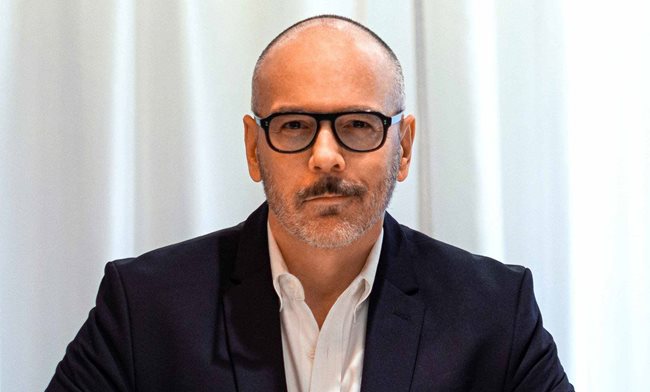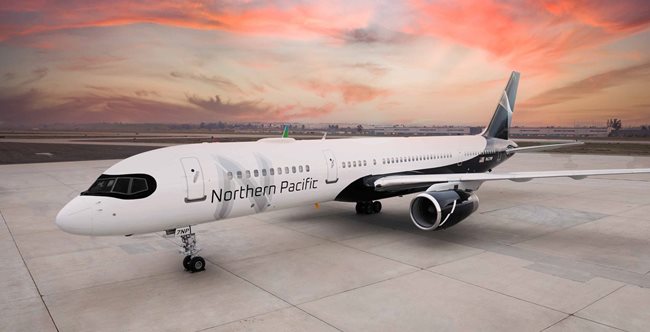Edmond Huot is a creative director and airline livery designer and shares more about developing the Northern Pacific brand.

Edmond Huot
As a creative director, can you share how you seek inspiration?
Being in the business for more than 30 years exposes you to a lot. I remain curious and open to the world - travelling, meeting people, and always framing and curating my experiences.
Growing up on a rural farm in Canada, devoid of cable TV and city-living, I was extremely bored and, hence, was forced to use my imagination. As an early av-geek and disaster movie fan, I would lose myself in thought - creating entire story plots and visual scenes with model airplanes that I’d build, play with outside, and ultimately crash in some snowbank.
I spent countless hours drawing planes on discarded paper bags and would act out scenes from Arthur Hailey’s Airport in my bedroom. For me, creativity started with storytelling and creating entire fantasy worlds in my head. Years later, my talent for drawing and sense of theatrics led me to advertising, where those same core passions drive my professional pursuits to this day.
While developing the Northern Pacific brand, can you share any challenges you encountered? And describe how you solved them?
A hurdle early on for me was understanding who the customer would be. Unlike larger, full-service multinational firms with the ability to cover more ground in terms of research and analysis, our agency is a smaller, more boutique company. We had to move fast, be resourceful, and quickly prioritise the core issues.
I worked closely with the client to better understand Asian cultural significance and hot points. At the same time, I was also speaking with the local team in Anchorage to highlight any concerns around misrepresenting their local indigenous communities.
Additionally, I developed a range of target profiling decks broken down into general categories such as leisure, business, and regulatory audiences. From there, I weaved all of those gathered quantitative insights into more contextualized thematic storytelling that gave a greater, more compelling meaning and purpose to the customer.
I titled the story: “We Are All Navigators.” So much of the subsequent design, including colours, typography, and positioning came from these valuable insights. By turning those data points into a greater story, I was able to elevate the brand in a more consumer-centric manner.
Another challenge that is often faced by startup airlines involves maximizing relatively small resources. How do I make the most out of a budget? Both the investors as well as the operators are extremely sensitive to how we go about spending time and money. You’ve got to get it right the first time.
How do you turn a conceptual design into a final product?
The process itself requires the ability to both understand and also separate abstract thinking (i.e. concepts and inspiration) from more linear thinking and action (i.e. design and production). When you’re in the conceptual phase you work with instinct and point of view but in the research or design phase, you work collaboratively with analysis and objectivity.
I often find myself wearing different hats at different times. It can be a bit draining but I’ve gotten used to it. Turning ideas into a physical deliverable also requires that you demonstrate to the client an understanding of their business challenges, that you are well-versed in the category, and that you ask a lot of questions and do a lot of listening. In order to perform, you need to learn.
This isn’t the first time you’ve designed a livery. Share your learnings from a past project that have contributed to the success of Northern Pacific’s brand
An airline livery project is different from the advertising and graphic design world because (A) these projects are often referral based and don’t come along as often, and (B) the level of risk mitigation when it comes to “getting it right” on an aircraft that costs upwards of $75m is so crucial.
I worked on a branding assignment involving a new livery design for Island Air - a small inter-island carrier based in Honolulu. The airline was being groomed for sale to Oracle founder Larry Elison. I remember getting a call on a Friday asking if I’d be interested and was told the client would require the initial concepts and design directions by the Wednesday of the following week.
Looking back, I realised that part of the project’s success depended on my team working quickly and efficiently. I faced a range of issues including creative resourcing, time management, and the politics of getting to “yes” when it came to the decision-making process.
Once the client approved the initial designs, our firm was propelled into an arduous schedule of commuting. I was flying every second week to Hawaii from New York, often with other creatives, such as designers, photographers, and videographers, in tow.
Because the airline business is a 24/7 concern, a huge strain was placed on my team as time zones became the real enemy. Just as our workday in Canada was coming to an end, the client’s day in Hawaii was just beginning. Anyone who ever thought that working on an airline account was glamorous quickly changed their tune! Still, some of my best experiences and relationships were made during this time. I still see that hectic chapter in my life as both formative and endearing.
Also of note, airline marketing is really akin to tourism campaigns. Because airlines are often such an important touch point for customers, the tone and messaging often speak to a broader idea. We weren’t just designing a brand or a livery, we were designing an experience- one that had to speak authentically to locals, not tourists.
Interestingly, similar to Northern Pacific Airways, Island Air was also an airline that catered in part to serving a more local, more indigenous audience. The carrier added value to the daily lives of its island inhabitants by serving as a mode of transportation for work, or to visit friends and family. We had to understand the cultural importance of “family” and the intense pride and association local communities had for their islands.
Also, similar to Northern Pacific Airways hub of Alaska, Island Air’s hub of Honolulu is somewhat remote and isolated geographically. This creates a cultural dynamic among the locals that must be understood and respected. There are so many interesting and valuable parallels between these two projects.
What’s it like being a leader in the design industry?
Leadership comes from understanding what makes creative people tick. Working with artists, you need to appeal to their artistic capabilities. At heart, I’m an artist, and I’m fond of finding individuals who share that passion. You need mutual respect and trust to relate to people and inspire them to do great work.
The other part of leadership is understanding the client’s goals and having the confidence and fortitude to deliver. Ultimately, from a creative perspective, I believe my clients are looking for me to lead with an original point of view. Everything else is somewhat of a commodity.
The trick for me from a leadership perspective is navigating that path forward. How does one balance the day-to-day hurdles involving deadlines, budgets, and the myriad of unforeseen challenges that come your way with a creative perspective that ultimately makes your work special or distinctive. How can I compel those who see their business as an operator to understand and appreciate a stylistic nuance or category-breaking concept. A good leader doesn’t shy away from being honest and forthright.
The team at Northern Pacific Airways, starting with their CEO, has afforded me the rare opportunity to do good work. This level of autonomy for me is rather sacred since it requires a greater level of trust and respect. In my experience, you can’t put a price on that.
Do you have any advice for those who are interested in a position like yours? How can they enter the design industry?
Those looking to enter this business need to be open to the world around them. They need to make themselves known - reach out and let people like me know who they are. Since we are not a big company, I bring on board a small number of creatives.
I am looking for a mix of ideation and craftsmanship - 21st-century artisans who are comfortable learning and experimenting with new technologies. Most likely the candidates who do well with me are people who also have a more entrepreneurial outlook. They are more comfortable with risk and can see beyond any immediate limitations. I am constantly looking for exceptional individuals.
You don’t have to be seasoned, but rather fresh, passionate, smart, and outspoken, or innately curious. If you’re that person, reach out - I’d love to meet you.


































